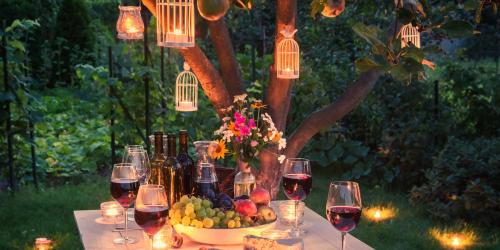We recover the ashes from the chimney
We cut if it does not freeze
We prepare the kitchen garden
We are watching his balcony
We illuminate her green plants
We humidify our indoor garden
Fruit trees are sprayed
The barks are unveiled
SOS, my plant has caught cold!
Weigh the weight of the snow
It is left as it is an excellent insulator that maintains a temperature close to zero degrees, even if the gel intensifies. But it is eliminated when it accumulates on the branches of evergreen conifers and shrubs. Risk of breakage!
The tools: a birch broom or a plastic fan rake to shake branches up.
We recover the ashes from the chimney
Spread on the ground, they create in spring "no slugs land" on which gastropods get bogged down before they can devour their favorite dishes: seedlings, young shoots, hostas, salads ... We can also bury them at the foot of trees fruit or vegetable garden. Or spread them on the compost pile. Rich in potash, the ashes of wood favor the harvest of fruits.
The tools: a bucket, a small shovel and a pair of gloves.
We cut if it does not freeze
As of January, take care of the summer blooming shrubs (buddléia, hibiscus, lavatera ...) and fruit trees (apple and pear). During February, it is the turn of the peach and apricot, the vine, the dogwood (to have beautiful red stems next winter), wisteria, clematis, ivy and hydrangeas.
At the end of February-beginning of March, we go on with the rose bushes, the border of santolines, the shrub sage and the fuchsia. Throughout the winter, the faded stems of perennial plants (sedum, aster, monard ...) and grasses are guarded because they are both aesthetic under the frost and useful to protect the stump of the frost. Cut them about 10 cm above ground level at the end of February, just before the start of vegetation.
• The tools: pruning shears, a special pair of "rosebush" gloves and an electric hedge trimmer if you have a lot of grasses.
We prepare the kitchen garden
Eliminate mulch on unplanted surfaces as they harbor a lot of pests, including slug eggs. Spread compost on the soil - or well decomposed manure - and flip the soil without crumbling it. The larvae and eggs of the updated parasites will be destroyed by frost.
Beginning in February, we can start the first sowing: carrots, beans, parsley, peas ... Advantages: useless watering - the spring rains do the work for us - and early harvests.
• Tools: a fork, a claw (to pick up mulch) and a small seed drill.
We are watching his balcony
Outside the freezing period, consider watering evergreen shrubs (boxwood, holly, laurel, skimmia ...) and coniferous trees. This gesture may seem strange in winter, but remains logical since these plants keep their leaves and continue to sweat.
Do not forget to raise the pots on pieces of polystyrene. This insulating material prevents the cold from rising from the ground to the roots. Keep protection for plants sensitive to snow or strong frost (camellia, mimosa, olive, oleander ...) if the winter hardens.
• Equipment: wintering veil (for foliage) or bubble plastic (for wrapping pots).
We illuminate her green plants
Bring them as close to windows as possible, lack of light in winter makes them more vulnerable to pests. If needed, light up your badly exposed plants with daylight type lamps. Be careful not to put foliage in direct contact with the glass that may be iced.
The material: skateboards to be able to move more easily the big pots.
We humidify our indoor garden
Water your indoor plants less and space fertilizer until next spring. On the other hand, moisten the leaves without moderation - except succulents and cacti - to compensate for the dryness of the air.
This quick action is enough to discourage insect attacks such as red spiders, small white flies and mealybugs. Use water at room temperature and not limestone, so as not to leave traces on the foliage.
• The equipment: a small vaporizer, an indoor mini-fountain, a mist fogger.
Fruit trees are sprayed
In January-February, treat fruit trees with paraffinic mineral oil against insect and mite pests. Then, at the end of winter, before the opening of the buds, make another treatment with Bordelaise Bouillie (against the overwintering forms of the diseases).
A paid and totally organic gesture, which will bear fruit in the months to come. To apply in dry weather, without wind and frost.
• The equipment: a pressure sprayer, a hat, a pair of gloves and a protective mask.
The barks are unveiled
It is in winter that one appreciates the best the colors and the texture of the barks of the trees: birch, maple, prunus ... Do not hesitate to carve the little twigs born directly on the trunk to clear this one . Eliminate the moss and black marks by washing the bark with Saint-Marc laundry or Marseille soap (non-polluting products).
Ignore the mocking looks of your surroundings and admire the result.
• The material: a pair of gloves and a sponge (especially no wire brush that would scratch the bark).
SOS, my plant has caught cold!
Above all, do not tear it off right away and give it a chance, at least until the end of spring. Each plant responds differently. Evergreen shrubs: cut the damaged parts of the twigs to the big branches if necessary and let the vegetation start again.
Palm and cycads: clean the damaged fins. The tree will be reborn from the central bud if it has not frozen. In June, you will be fixed.
Geranium, bougainvillea: if there are still some stems firm and small buds, nothing is lost, it will be enough to cut the parched parts. Mimosa, fig, eucalyptus: even completely grilled, they leave very often from the base, sometimes several weeks later.
The material: a pruner, a pruner and a small saw handsaw.


